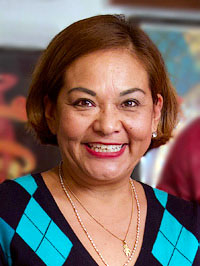What specific strategies can improve outcomes for these children?
Page 7: High School and Beyond
 When students enter high school, they typically assume a greater degree of independence and responsibility than when they were in elementary and middle school. The degree of independence and responsibility gradually increases with each year of high school, with the goal being that students can function independently when they graduate. However, students with ASD, ages 15 to 22, often need explicit instruction and extra supports to perform tasks independently and to behave appropriately in a variety of settings. Although a number of the 27 EBPs identified by the National Professional Development Center have been shown to be effective for addressing these skills, two will be highlighted on this page: self-management strategies and technology-aided instruction and intervention.
When students enter high school, they typically assume a greater degree of independence and responsibility than when they were in elementary and middle school. The degree of independence and responsibility gradually increases with each year of high school, with the goal being that students can function independently when they graduate. However, students with ASD, ages 15 to 22, often need explicit instruction and extra supports to perform tasks independently and to behave appropriately in a variety of settings. Although a number of the 27 EBPs identified by the National Professional Development Center have been shown to be effective for addressing these skills, two will be highlighted on this page: self-management strategies and technology-aided instruction and intervention.
Self-Management Strategies
Self-management refers to a number of strategies that can be used to help students engage in appropriate or desired behavior. Through the use of these strategies students become more aware of their behaviors and how to distinguish between appropriate and inappropriate behaviors, a very important skill for students who typically have a difficult time understanding social norms and rules.
For students ages 15–22, self-management strategies have been shown to be effective for addressing behavioral, school readiness, and vocational outcomes. These strategies have also been effectively used with students ages 3–14 to improve social, communication, academic, and play outcomes. Self-management strategies can be used in isolation, but more often they are used in combination. The table below highlights four self-management strategies. In the examples, notice that Michelle is using self-monitoring, self-instruction, and self-reinforcement to address challenges in a number of areas. Notice also that self-monitoring and self-reinforcement are used in combination to address Michelle’s times management issues.
Students learn to self-assess their behavior and record the results. Though it does not create new skills or knowledge, this strategy does increase or decrease the frequency, intensity, or duration of existing behavior.
Example: Each day, Michelle will list the activities she needs to complete. As she completes each activity, she places a checkmark beside it on her checklist.
Michelle’s Recording Sheet
Monday
Morning
6:00 get up and get ready
6: 30 walk the dog
6:45 catch the bus
Afternoon
3:00 Science club
4:00 Meet Mom for pick-up
6:00-8:00 complete daily homework
8:00-9:00 work on term paper
Students learn to talk themselves through a task or activity. Also referred to as self-talk or self-statements.
Example: When Michelle starts rocking back and forth in her chair, she says to herself, “Stop. Take three deep breaths.
Students learn how to set and monitor their progress toward achieving the goal.
Example: Michelle has set a goal for organizing her classroom assignments. Her goal is: For the next two weeks, I will place all completed assignments in my binder as soon as I complete them at least 80% of the time.
Students select a reinforcer (i.e., a tangible object, a social activity, or an activity) and reward themselves for reaching or exceeding a criterion.
Example: If Michelle records and completes her daily activities at least 4 out of 5 days, she will reward herself with a movie with friends.
To learn more about these self-management strategies, visit the following IRIS Module:
Technology-Aided Instruction and Intervention
 Technology-aided instruction and intervention (TAII) includes a range of technology supports that students can use to achieve a goal. These include, but are not limited to, computer-assisted instruction (CAI), computers, smartphones, and tablets. Following are several examples:
Technology-aided instruction and intervention (TAII) includes a range of technology supports that students can use to achieve a goal. These include, but are not limited to, computer-assisted instruction (CAI), computers, smartphones, and tablets. Following are several examples:
computer-assisted instruction (CAI)
Classroom instruction that makes use of computers or computer programs to teach new content or skills or to remediate undesirable behaviors.
- A student uses video prompts to learn daily living skills.
- A student uses interactive computer software with avatar assistants to learn how to recognize facial expressions and emotions.
- A student uses a smartphone to prompt him to record homework assignments.
Many students 15–22 have used technology since an early age and many use different forms of technology throughout the day. As a whole, they find technology to be engaging, they favor it over other activities, and they prefer the visual presentation of information that it offers. However, technology should not be used to supplant social interactions, as these skills will need to be generalized to social contexts. It is also important to understand that all technology supports might not be effective for all students in every situation. To help determine the appropriateness of technology for a given student, the Center on Secondary Education for Students with ASD (CSESA) recommends considering the following variables:
- Student characteristics (e.g., enjoys using technology, prefers visual presentation of information)
- Activity for which the technology will be used
- Technology features, ease of use, and reliability
- Context in which the technology will be used (e.g., home, school, work)
TAII has been shown to be effective with students ages 15–22 in almost all outcome areas, including social, communication, behavior, school readiness, adaptive, vocational, and academic. It has also been shown to be effective for students 3–14 in a large number of outcome areas. In the video below, Mia demonstrates how she uses TAII to help prepare for dinner time (time: 2:54).
Mia: Hi, my name is Mia, and I’m going to show you how to do my nighttime routine. Mom: First activity is “wash hands.” She has thirty seconds.
[Mia washes her hands in the kitchen sink.]
Mia: Five, four, three, two, one!
[The tablet computer chimes.]
Mom: Close the water. You did it! Dry your hands, and you’re done. Dry your hands. Okay, and you come here and put it on “all done.”
[Mia presses buttons on the tablet computer’s screen.]
Tablet computer: Wash hands…all done.
Mom: Set the table.
[Mia collects utensils from a drawer.]
Mia: I need forks.
Mom: A fork and a knife, please. Just for you. Just for you. Okay.
[Mia sets the kitchen table]
Mom: You’re doing such a great job. I like how you’re setting the table. You have twenty-nine seconds. That is great, Mia. All right. Done?
Mia: Done. All done.
[Mia presses buttons on the tablet computer’s screen.]
Tablet computer: All done.
Mia: Wow! I beat up the timer!
Mom: You did beat the timer. Now what is next. What is next?
[Mia folds napkins and places them on the placemats.]
Mom: Oh, she is folding the napkins. Thank you. So everybody will have something nice. Good, good, and now it’s time to sit.
[Mia sits at the table.]
Mom: Very good.
Mia: Oh, look how Lady is drinking her water.
Mom: It is drinking her water. Okay. And all done sitting?
Mia: Thanks for watching!
[Mia presses buttons on the tablet computer’s screen.]
Tablet computer: All done.
Mia: Bye-bye!
Mom: I’m going to eat my dinner.
Mia: I’m going to eat my dinner!
Listen now as Mia’s mother shares her personal insights into some of the positives and drawbacks of technology use.

Luz
Mia’s Mother
(time: 0:48)
Mom: The iPad is a good thing, and it’s a bad thing. It’s a good thing because, I think, with children with autism it really gives them the socialization that they are missing. They see situations, and they learn from the situations, because they’re so technologically advanced. The iPad has been great, especially when she was smaller. Now I can just do a routine in fifteen minutes rather than just cutting every single picture. They have come up with wonderful applications. So it’s been good for me, too. It’s easy, but you have to use it every single day for it to work. She knows it has the timer, and she loves to say “goal met,” and she knows now that it’s time for reward.
For Your Information
 The Center on Secondary Education for Students with Autism Spectrum Disorder (CSESA) is a research and development project funded by the U.S. Department of Education. CSESA offers a wealth of resources for working with high school students with autism, including case studies highlighting some of the EBPs featured in this module. Kara Hume, a principal investigator at CSESA, discusses one of the primary objectives of the center, which is building the skills of secondary students in four main areas: transition and families, independence and behavior, peer and social competence, and academics.
The Center on Secondary Education for Students with Autism Spectrum Disorder (CSESA) is a research and development project funded by the U.S. Department of Education. CSESA offers a wealth of resources for working with high school students with autism, including case studies highlighting some of the EBPs featured in this module. Kara Hume, a principal investigator at CSESA, discusses one of the primary objectives of the center, which is building the skills of secondary students in four main areas: transition and families, independence and behavior, peer and social competence, and academics.
Kara Hume, a principal investigator at CSESA, discusses one of the primary objectives of the center, which is building the skills of secondary students in four main areas: transition and families, independence and behavior, peer and social competence, and academics.
Kara Hume, PhD
Research Scientist, Frank Porter Graham Child Development Institute
University of North Carolina-Chapel Hill
(time: 2:46)

Transcript: Kara Hume, PhD
We know that the post-high school outcomes are not good for our high school students on the autism spectrum, and we consider high school really the last, best chance for students to receive high-quality interventions. In my work with the Center on Secondary Education for Students with Autism, or CSESA, we focus on building skills in four main areas. The first domain we call the transition area, which is broad. It includes a focus on involving the students in the IEP process, enhancing self-determination and self-advocacy. We also focus on work-based learning experiences that address both college-readiness and career-readiness. And then we work with students and staff to help build connections with community resources, so connecting students and families to resources across the school and community that can help them as they move from the high school to the post-high school experience.
The next thing we focus on we call independence and behavior. And, really, it emphasizes enhancing adaptive behaviors. How can we build skills that will support independence across the school day? So supporting organization, helping students better plan for what their needs are, identify what their goals are, turning in assignments, completing homework, job-type skills that could be demonstrated on campus or off campus.
We also focus on peer and social competence. We spend time working with staff to teach specific social skills, but our bigger emphasis is really helping schools to help our students with autism build social connections across the school, so using peer-mediated interventions to build social networks and to help our students with autism be a part of a school community.
And the last area we work with schools on focuses on academics, specifically targeting comprehension, helping students read to learn and also learn to read. And we work with schools and staff on using those identified evidence-based practices to enhance skills in all of these domains.
There are a few other areas to consider when we think about the needs of high school students. Mental health needs is a high priority, needs related to sexuality and relationships, and also needs related to communication that are beyond the needs related to relating to peers but perhaps supporting students in the use of augmentative communication devices or technology assisted communication.
TIPS: Engaging and Supporting Student Transitioning to High School and Beyond
When they transition to high school, students with ASD often have fears and anxieties about taking part in physical education class, getting lost, using a locker, meeting new teachers, organizing personal belongings, and forming peer relationships. Teachers can help alleviate these fears by:
- Meeting with the student before school starts and allowing the student to ask questions about the class
- Providing a tour or map of the school before classes start
- Going through the locker-opening sequence and providing visual supports of the process if necessary
- Discussing the PE routine (e.g., changing in locker room)
- Encouraging students to engage in leisure activities, clubs, and sports teams to help create opportunities for friendships
Students might also have difficulty with transitions that occur within the school day itself (i.e., switching teachers; moving from one classroom or setting to another; or changing from one activity, instructional format, or academic subject to another). To help students during these transitions, teachers can provide transition supports—visual or auditory cues that can be provided before, during, or after a transition. An alternative is to use peer buddies to help students during transitions.
Additionally, students with ASD typically have difficulty with the transition from high school to life after high school—often referred to as secondary transition. At this point, they often enter a world of unfamiliar routines, new and unpredictable environments, and novel experiences. To learn more about the secondary transition process and the importance of partnering with agencies to improve post-secondary outcomes for students with disabilities, view the following IRIS Modules: